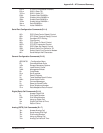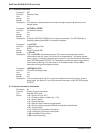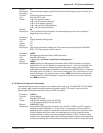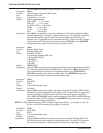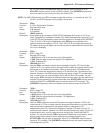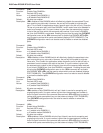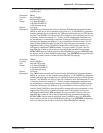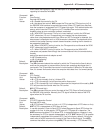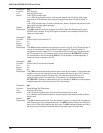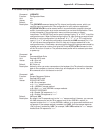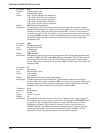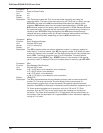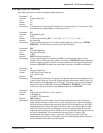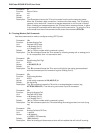
Appendix D - AT Command Summary
RF300E/RF310E 131
occur before dialing begins. See the description of S-register S80 for further details
regarding its interaction with $Dn.
Command: &En
Function: Flow Control
Unit: Decimal ASCII code
Values: n=3—Disable flow control by the TA.
n=4—Hardware flow control. &E4 causes the TA to use the CTS signal on pin 5 of
the RS232E/V.24 interface to regulate flow control. When CTS goes low, data flow
from the computer is suspended until CTS goes high again. This method works with
pacing, which uses the RTS signal on pin D. Hardware flow control cannot be
enabled unless an error correction protocol is selected.
n=5—XON/XOFF flow control. This is an in-band method, in which the XON and
XOFF characters (^Q and ^S respectively) are inserted into the data stream,
rather than using separate control lines. When an XOFF character is detected, the
data stream is suspended until an XON character is detected. The drawback to this
method is that some files may contain these characters, causing the file transfer to
be suspended indefinitely.
n=6—When XON/XOFF pacing is active, the TA responds to and discards the XON/
XOFF characters from the computer.
n=7—When XON/XOFF pacing is active, the TA responds to the XON/XOFF
characters and passes them through the communications link to the remote device,
thereby
pacing the remote terminal adapter as well.
n=12—Disable pacing.
n=13—Enable pacing.
Default: &E4, &E6, &E13
Description: The &En command selects the method by which the TA controls the flow of data to
and from the computer, to prevent either device from accepting data faster than it
can handle. The TA provides flow control in both directions. When the TA halts data
flow, it is termed flow control; when the computer halts data flow, it is termed pacing.
Command: &Rn
Function: CTS Control
Unit: Decimal ASCII code
Values: n=0—CTS acts normally; that is, it follows RTS.
n=1—CTS is forced high, but still provides online flow control.
n=2—CTS is forced high, but it drops on disconnect for the period of time set by S10.
CTS still provides flow control when the TA is online.
Default: &R1 (CTS forced high)
Description: The &Rn command lets you control the state of the CTS (Clear to Send) signal on
the RS232E/V.24 interface. Normally the CTS signal follows the state of the RTS
signal when the TA is online.
Command: &RFn
Function: CTS/RTS Interaction Control
Unit: Decimal ASCII code
Values: n=0 (CTS follows RTS when on-line), n=1 (CTS is independent of RTS when on-line)
Default: &RF1 (CTS is independent of RTS when on-line)
Description: In normal operation, Clear-to-Send (CTS) follows Request-to-Send (RTS) when the
modem is on-line. In other words, if RTS goes off, CTS goes off in response. The
&RF0 command enables CTS to follow RTS. In some applications, however, it may
be necessary for CTS to operate independently of RTS. &RF1 allows CTS to operate
independently regardless of the state of RTS, and is the factory default. If this is the
case, refer to the &R command for control of the Clear-to-Send signal. The &RFn
command has effect only when using &R0 (CTS acts normally—CTS follows RTS).



